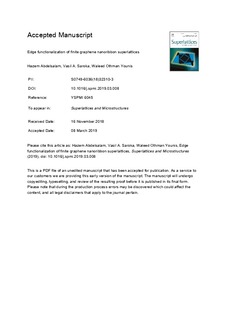| dc.contributor.author | Abdelsalam, H. | |
| dc.contributor.author | Saroka, Vasil | |
| dc.contributor.author | Younis, W.O. | |
| dc.date.accessioned | 2019-04-11T07:18:11Z | |
| dc.date.available | 2019-04-11T07:18:11Z | |
| dc.date.created | 2019-04-09T17:20:27Z | |
| dc.date.issued | 2019 | |
| dc.identifier.citation | Superlattices and Microstructures. 2019, 129 54-61. | nb_NO |
| dc.identifier.issn | 0749-6036 | |
| dc.identifier.uri | http://hdl.handle.net/11250/2594123 | |
| dc.description.abstract | The effect of chemical functionalization on the electronic properties of graphene nanoribbon superlattices with zigzag and armchair terminations is investigated using the density functional theory. The calculated positive binding energies imply that all the considered structures are stable before and after chemical modifications. The superlattices with armchair edges are characterized by a wide energy gap while those with zigzag edges have a narrow energy gap. The energy gap in superlattices with armchair edges nearly independent of their length while it strongly decreases and almost closes in superlattices with zigzag edges. The energy gap is comparably sensitive to the width variations in both types of the superlattices. It was found that the electric dipole moment increases with increasing the width in the case of armchair while it oscillates in zigzag superlattices. The electric dipole moment can be enhanced by chemical functionalization with COOH and NH2 groups. The effect of this functionalization is moderate for the energy gap, but the adsorption of tetracyanoquinodimethane transforms the system from insulator (Eg = 2.66 eV) to a narrow band gap semiconductor (Eg = 0.25 eV). The adsorption energy of tetracyanoquinodimethane and tetrathiafulvalene molecules can be enhanced by chemical functionalization which makes graphene superlattices useful for sensor applications and wastewater treatment. | nb_NO |
| dc.description.abstract | Edge functionalization of finite graphene nanoribbon superlattices | nb_NO |
| dc.language.iso | eng | nb_NO |
| dc.publisher | Elsevier | nb_NO |
| dc.relation.uri | https://doi.org/10.1016/j.spmi.2019.03.008 | |
| dc.rights | Attribution-NonCommercial-NoDerivatives 4.0 Internasjonal | * |
| dc.rights.uri | http://creativecommons.org/licenses/by-nc-nd/4.0/deed.no | * |
| dc.title | Edge functionalization of finite graphene nanoribbon superlattices | nb_NO |
| dc.type | Journal article | nb_NO |
| dc.type | Peer reviewed | nb_NO |
| dc.description.version | acceptedVersion | nb_NO |
| dc.subject.nsi | VDP::Teoretisk kjemi, kvantekjemi: 444 | nb_NO |
| dc.subject.nsi | VDP::Theoretical chemistry, quantum chemistry: 444 | nb_NO |
| dc.source.pagenumber | 54-61 | nb_NO |
| dc.source.volume | 129 | nb_NO |
| dc.source.journal | Superlattices and Microstructures | nb_NO |
| dc.identifier.doi | 10.1016/j.spmi.2019.03.008 | |
| dc.identifier.cristin | 1691210 | |
| dc.relation.project | Norges forskningsråd: 262633 | nb_NO |
| dc.relation.project | Norges forskningsråd: 274853 | nb_NO |
| dc.description.localcode | © 2019. This is the authors’ accepted and refereed manuscript to the article. Locked until 9 March 2021 due to copyright restrictions. This manuscript version is made available under the CC-BY-NC-ND 4.0 license http://creativecommons.org/licenses/by-nc-nd/4.0/ | nb_NO |
| cristin.unitcode | 194,66,20,0 | |
| cristin.unitname | Institutt for fysikk | |
| cristin.ispublished | true | |
| cristin.fulltext | postprint | |
| cristin.qualitycode | 1 | |

